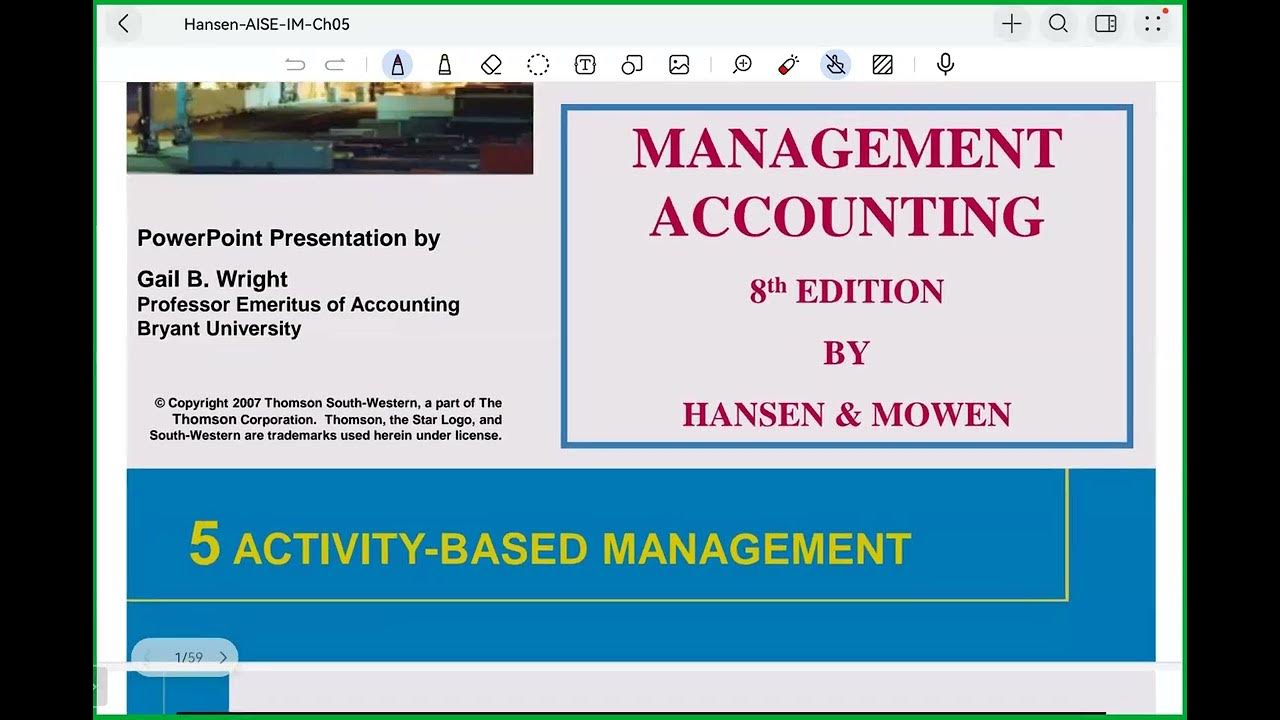Activity Based Management 2
Summary
TLDRThis transcript delves into the comparison between financial-based and activity-based organizations, exploring how performance is measured, evaluated, and improved in each model. It covers topics such as standard costing, activity analysis, value-added vs non-value-added activities, and cost reduction strategies. Activity-based management (ABM) is discussed as a tool for enhancing organizational efficiency by identifying areas for improvement and reducing waste. The importance of understanding root causes of activity costs and using value analysis for continuous improvement is highlighted, alongside practical techniques like Kaizen costing, benchmarking, and trend analysis.
Takeaways
- 😀 Financial-based organizations focus on unit budgets, standard costing, and financial performance metrics, while activity-based organizations emphasize process improvement through dynamic standards and value-added activities.
- 😀 Financial performance is measured by comparing actual costs against standard costs, while activity-based organizations measure performance through time reduction, quality improvement, and cost reduction.
- 😀 Activity-based management (ABM) encourages employees to share in the improvement process, providing them flexibility to enhance project benefits.
- 😀 Value analysis (PVA) focuses on understanding the drivers behind activity costs and identifying ways to improve system-wide cost efficiency.
- 😀 Root cause analysis is crucial because solving one problem can impact multiple related activities, potentially improving overall efficiency in the process.
- 😀 Activities in an organization can be classified as value-added or non-value-added, with value-added activities contributing directly to business goals and non-value-added activities causing inefficiencies.
- 😀 Non-value-added activities, such as excessive scheduling, inspection, and movement, lead to wasted time and increased costs. Eliminating these inefficiencies is essential for reducing production costs.
- 😀 Cost reduction efforts focus on eliminating non-value-added activities and streamlining processes to improve efficiency, using methods such as time reduction and shared activities for economies of scale.
- 😀 Activity performance can be measured using both financial and non-financial metrics, such as assessing the efficiency of input-output relationships and reducing wasted time in production.
- 😀 Kaizen costing and benchmarking help organizations continuously improve their processes by comparing their activities to best practices and seeking opportunities for incremental cost reductions.
- 😀 Activity-based costing (ABC) applied to customers and suppliers helps managers identify cost-reduction opportunities in relationships with customers and suppliers, ensuring more efficient and cost-effective processes.
Q & A
What is the key difference between financial-based and activity-based organizations in terms of measurement?
-Financial-based organizations measure performance using financial metrics like unit budget, standard costing, and variances between actual and standard costs. Activity-based organizations focus on process improvement, using measures like time reduction, quality improvement, and trend analysis.
How does the evaluation process differ between financial-based and activity-based performance?
-In financial-based evaluation, performance is assessed through financial efficiency, controllable costs, and comparing actual versus standard costs. In contrast, activity-based performance evaluation uses time, quality, efficiency, and process improvements as metrics.
Why is understanding the root cause of an activity important in activity-based management?
-Understanding the root cause of an activity is important because one activity's problem can affect related activities. Identifying root causes helps to prevent issues like defective products and inefficiencies that disrupt the production process.
What is the difference between value-added and non-value-added activities in the context of activity-based management?
-Value-added activities are essential for achieving business goals and improving performance, while non-value-added activities are unnecessary and lead to inefficiencies. Eliminating non-value-added activities reduces costs and enhances operational efficiency.
How can non-value-added activities be eliminated in a production process?
-Non-value-added activities can be eliminated gradually through continuous improvement, such as optimizing scheduling, reducing inspection times, and improving product quality to prevent defects and unnecessary rework.
What role does value analysis (PVA) play in activity-based management?
-Value analysis (PVA) focuses on improving cost efficiency by analyzing activities and their inputs and outputs. It aims to identify inefficiencies, optimize processes, and reduce costs by eliminating non-value-added activities.
What is Kaizen costing, and how does it help reduce costs?
-Kaizen costing is a method of continuous improvement focused on reducing costs by incrementally improving processes and maintaining efficiency. It emphasizes making small, consistent improvements over time to reduce waste and improve performance.
How is performance measured in activity-based management?
-Performance in activity-based management is measured using both financial and non-financial metrics, including efficiency (relationship between input and output), time reduction, and quality. This helps identify areas for improvement and optimize activities.
How does benchmarking contribute to activity-based management?
-Benchmarking involves comparing an organization's activities to best practices or industry standards. It helps identify areas for improvement and establishes performance goals to optimize processes and achieve better efficiency.
What is the importance of activity-based customer and supplier costing?
-Activity-based customer and supplier costing helps managers identify and reduce costs associated with customer and supplier relationships. It provides insights into optimizing these relationships based on quality, reliability, and cost efficiency.
Outlines

This section is available to paid users only. Please upgrade to access this part.
Upgrade NowMindmap

This section is available to paid users only. Please upgrade to access this part.
Upgrade NowKeywords

This section is available to paid users only. Please upgrade to access this part.
Upgrade NowHighlights

This section is available to paid users only. Please upgrade to access this part.
Upgrade NowTranscripts

This section is available to paid users only. Please upgrade to access this part.
Upgrade NowBrowse More Related Video

Performance Management Systems in the Public Sector Module2

ONLINE CLASS EPISODE 28: MANAJEMEN SDM BERBASIS KOMPETENSI

Activity Based Management 1

Econofísica - 8 Modelando cenários com melhores hipóteses Excel

Sistema Jurídico Common Law

Maven vs Gradle: Which Is Better? | Maven & Gradle Difference | Devops Tools Explained | Simplilearn
5.0 / 5 (0 votes)